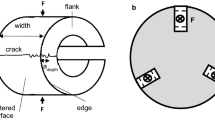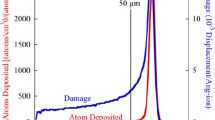Abstract
Zirconia–5 mol% yttria has been used successfully for pH sensing in high temperature water (≥300 °C). However, this material, which consists of the cubic phase with 2–8 vol.% intergranular tetragonal precipitates, is not always stable in this environment and some batches were found to be fragmented by cracking within a few days. To study this effect, different samples of the material were structurally characterised and exposed to 300 °C water. It was found that the susceptibility to cracking increased with the volume content of the intergranular precipitates. The cracking mechanism was explained by the stress-induced grain boundary cracking of the cubic phase, the stress being due to the water-induced martensitic transformation of the tetragonal precipitates. A model has been proposed which allows to interpret the dependence of crack formation propensity on the size of the tetragonal precipitates.










Similar content being viewed by others
References
Bosch R-W, Wéber M, Vandermeulen W (2009) Power Plant Chem 11:30
Scott HG (1975) J Mater Sci 10:1527. doi:10.1007/BF01031853
Stubican VS, Hink RC, Pray SP (1978) J Am Ceram Soc 61:17
Heuer H, Rüle M (1984) In: Claussen N, Rühle M, Heuer HA (eds) Advances in ceramics, vol 12, Proceedings of international conference on the science and technology of zirconia II, Stuttgart 1983. American Ceramic Society, Columbus, OH
Sato T, Ohtaki TS, Shimada M (1985) J Mater Sci 20:1466. doi:10.1007/BF01026344
Kobayashi K, Kuwajima H, Masaki T (1981) Solid State Ionics 3–4:489
Nakajima K, Kobayashi K, Murata Y (1984) In: Claussen N, Rühle M, Heuer HA (eds) Advances in ceramics, vol 12, Proceedings of international conference on the science and technology of zirconia II, Stuttgart 1983. American Ceramic Society, Columbus, OH
Sato T, Shimada M (1985) J Am Ceram Soc 68:356
Chevalier J, Cales B, Drouin JM (1999) J Am Ceram Soc 82:2150
Pyyapilly PP, Butt DP (2007) J Nucl Mater 360:92
Kim D, Jung H-J, Cho D-H (1995) Solid State Ionics 80:67
Lange FF (1986) J Am Ceram Soc 69:240
Guo X (1999) J Phys Chem Solids 60:539
Yoshimura M, Noma T, Kawabata K, Somiya S (1987) J Mater Sci Lett 6:465
Guo X (2004) Chem Mater 16:3988
Guo X (2000) Phys Status Solidi (a) 177:191
Guo X, He J (2003) Acta Mater 51:5123
Annamalai VE, Gokularathnam CV, Krishnamurthy R (1992) J Mater Sci Lett 11:824
Modin H, Modin S (1973) Chap. 5 in Metallurgical Microscopy. Butterworth, London
Anstis R, Chantikul P, Lawn BR, Marshall DB (1981) J Am Ceram Soc 64:533
Miller RA, Smialek JL, Garlick RG (1981) In: Heuer AH, Hobbs LW (eds) Advances in ceramics, vol 3, Proceedings of 1st international conference on the science and technology of zirconia, Cleveland, OH, 1980. American Ceramic Society, Columbus, OH
Lanteri V, Heuer HA, Mitchell TE (1984) In: Claussen N, Rühle M, Heuer HA (eds) Advances in ceramics, vol 12, Proceedings of international conference on the science and technology of zirconia II, Stuttgart 1983. American Ceramic Society, Columbus, OH
Tsubakino H, Fujiwara T, Satani K, Ioku S (1997) J Mater Sci Lett 16:1472
Gremillard L, Epicier T, Chevalier J, Fantozzi G (2005) J Eur Ceram Soc 25:875
Matsui K, Yoshida H, Ikuhara Y (2008) Acta Mater 56:1315
Tekeli S (2006) Mater Des 27:230
Porter L, Heuer AH (1979) J Am Ceram Soc 62:298
Montross CS (1992) J Am Ceram Soc 75:463
Matsui M, Soma T, Oda I (1984) In: Claussen N, Rühle M, Heuer HA (eds) Advances in ceramics, vol 12, Proceedings of international conference on the science and technology of zirconia II, Stuttgart 1983. American Ceramic Society, Columbus, OH
Kriven WM, Fraser WL, Kennedy SW (1981) In: Heuer AH, Hobbs LW (eds) Advances in ceramics, vol 3, Proceedings of 1st international conference on the science and technology of zirconia, Cleveland, OH, 1980. American Ceramic Society, Columbus, OH
Rühle M, Heuer HA (1984) In: Claussen N, Rühle M, Heuer HA (eds) Advances in ceramics, vol 12, Proceedings of international conference on the science and technology of zirconia II, Stuttgart 1983. American Ceramic Society, Columbus, OH
Green DR (1981) J Am Ceram Soc 64:138
Dériano S, Jarry A, Rouxel T, Sangleboeuf J-C, Hampshire S (2004) J Non-Cryst Solids 344:44
Sakaguchi S, Sawaki Y, Abe Y, Kawasaki T (1982) J Mater Sci 17:2878. doi:10.1007/BF00644665
Tada H, Paris P, Irwin G (1973) The stress analysis of cracks handbook. DEL Research Corporation, St. Louis
Author information
Authors and Affiliations
Corresponding author
Appendix
Appendix
In this section, the stress intensity factor K I is calculated for a crack ahead of a row of transformed precipitates as shown in Fig. 9. The distance between the transformation fronts approaching each other from both sides of the sample is 2b and the distance between the crack fronts is 2a. Therefore, the crack ahead of the last transformed particle has a length (b − a). This crack has to grow to a length d to reach the next particle. It follows that (b − a) values up to the interparticle distance, i.e. about 50 μm, have to be considered.
The lower part of Fig. 9 schematises the geometry by replacing the effect of the transformed particles by wedges of thickness 2 h inserted from both surfaces up to the innermost transformed particle. For this configuration, consisting of two wedges in a finite thickness plate no analytical expression for K I was found. However, a solution for two wedges in an infinite specimen has been given by Tada [35]. This has been used since it is thought to be a good approximation, provided the wedge insertion depth is sufficient for surface proximity to be negligible.
The stress intensity factor given by Tada for the configuration shown in the lower part of Fig. 9, is as follows:
where E is Young’s modulus (200 GPa), h is the half wedge thickness, a is defined above and K is a function of k tabulated in Appendix J.1 of [35] and
Cracks growing from a transformed to an untransformed particle have a length (b − a) which is always shorter than the interparticle spacing d. This means that, except for very small ligament sizes, a/b is close to 1 and k is close to zero. This allows to approximate (4) as
For small k, K(k) is nearly constant and equal to 1.6. After modification, (3) can then be written as
There is no obvious way to express h as a function of precipitate size and distribution. To avoid this problem h was calculated supposing the average equivalent particle diameter 2R (Table 1) to determine the wedge height 2 h. Supposing that the particles show an isotropic linear expansion of 1.0% [29, 30], the expression for h is
Introducing (7) in equation (6) gives K I as a function of crack size (b − a) and average precipitate diameter 2R
Equation (8) was used to calculate the curves in Fig. 10.
It is acknowledged that considerable simplifications were necessary to arrive at expression (8). For example, only cracks perpendicular to the sample surface are considered, whereas in reality cracks occur in all directions. Furthermore, the precipitate density does not appear in the final expression. The absolute values for the stress intensity factor therefore should be considered with caution. However, the simplifying assumptions should affect the ranking of the three material types to a much lesser degree. The conclusion that the cracking propensity is dependent on the size of the intergranular tetragonal precipitates is therefore likely to be acceptable.
Rights and permissions
About this article
Cite this article
Vandermeulen, W., Bosch, RW., Leenaers, A. et al. Degradation of 5 mol% yttria–zirconia by intergranular cracking in water at 300 °C. J Mater Sci 45, 5502–5511 (2010). https://doi.org/10.1007/s10853-010-4608-z
Received:
Accepted:
Published:
Issue Date:
DOI: https://doi.org/10.1007/s10853-010-4608-z




